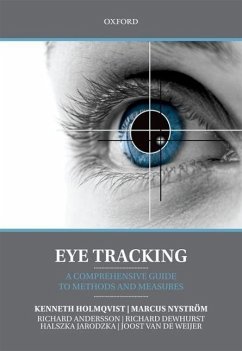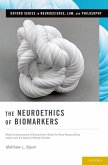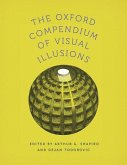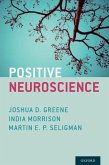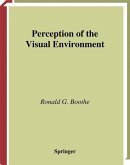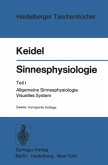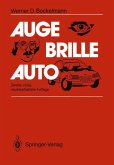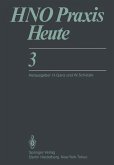Kenneth Holmqvist, Marcus Nystrom, Richard Andersson, Richard Dewhurst, Halszka Jarodzka, Joost van de Weijer
Eye Tracking
Kenneth Holmqvist, Marcus Nystrom, Richard Andersson, Richard Dewhurst, Halszka Jarodzka, Joost van de Weijer
Eye Tracking
- Gebundenes Buch
- Merkliste
- Auf die Merkliste
- Bewerten Bewerten
- Teilen
- Produkt teilen
- Produkterinnerung
- Produkterinnerung
Eye movements are crucial in helping to deal with the vast amounts of information we encounter in our everyday lives. This book is a comprehensive handbook of eye tracking methodology. It describes how to evaluate and acquire an eye-tracker, how to plan and design a study, and how to record and analyse eye-movement data
Andere Kunden interessierten sich auch für
![Neuroethics of Biomarkers Neuroethics of Biomarkers]() Matthew L BaumNeuroethics of Biomarkers92,99 €
Matthew L BaumNeuroethics of Biomarkers92,99 €![Oxf Compendium Visual Illusions C Oxf Compendium Visual Illusions C]() Oxf Compendium Visual Illusions C389,99 €
Oxf Compendium Visual Illusions C389,99 €![Positive Neuroscience Positive Neuroscience]() Positive Neuroscience126,99 €
Positive Neuroscience126,99 €![Perception of the Visual Environment Perception of the Visual Environment]() Ronald G. BoothePerception of the Visual Environment38,99 €
Ronald G. BoothePerception of the Visual Environment38,99 €![Sinnesphysiologie Sinnesphysiologie]() Wolf D. KeidelSinnesphysiologie54,99 €
Wolf D. KeidelSinnesphysiologie54,99 €![Auge ¿ Brille ¿ Auto Auge ¿ Brille ¿ Auto]() Werner D. BockelmannAuge ¿ Brille ¿ Auto119,99 €
Werner D. BockelmannAuge ¿ Brille ¿ Auto119,99 €![HNO Praxis Heute HNO Praxis Heute]() HNO Praxis Heute54,99 €
HNO Praxis Heute54,99 €-
-
-
Eye movements are crucial in helping to deal with the vast amounts of information we encounter in our everyday lives. This book is a comprehensive handbook of eye tracking methodology. It describes how to evaluate and acquire an eye-tracker, how to plan and design a study, and how to record and analyse eye-movement data
Hinweis: Dieser Artikel kann nur an eine deutsche Lieferadresse ausgeliefert werden.
Hinweis: Dieser Artikel kann nur an eine deutsche Lieferadresse ausgeliefert werden.
Produktdetails
- Produktdetails
- Verlag: Hurst & Co.
- Seitenzahl: 560
- Erscheinungstermin: 1. November 2011
- Englisch
- Abmessung: 254mm x 176mm x 38mm
- Gewicht: 1127g
- ISBN-13: 9780199697083
- ISBN-10: 0199697086
- Artikelnr.: 33935787
- Herstellerkennzeichnung
- Libri GmbH
- Europaallee 1
- 36244 Bad Hersfeld
- gpsr@libri.de
- Verlag: Hurst & Co.
- Seitenzahl: 560
- Erscheinungstermin: 1. November 2011
- Englisch
- Abmessung: 254mm x 176mm x 38mm
- Gewicht: 1127g
- ISBN-13: 9780199697083
- ISBN-10: 0199697086
- Artikelnr.: 33935787
- Herstellerkennzeichnung
- Libri GmbH
- Europaallee 1
- 36244 Bad Hersfeld
- gpsr@libri.de
Kenneth Holmqvist is an associate professor in Cognitive Science at Lund university, where he founded the eye-tracking laboratory in 1995, which later grew into the large Humanities Laboratory. He has worked in a large variety of eye-tracking-based research stretching from reading research and scene perception, over to newspaper reading, advertisement studies and gesture recognition in face-to-face interaction. Kenneth also has expertise in eye tracking used in applied areas, including decision making in supermarkets and research on safety in car driving and air traffic control. In 2000, Kenneth initiated regular master courses in eye-tracking methodology. In 2006, he founded the Scandinavian Conference on Applied Eye-tracking, and in 2008, the international LETA training courses in eye-tracking methodology. Kenneth is the initiator and main author of this book. Marcus Nyström received his PhD in Information Theory from the department of Electrical and Information Technology at Lund University, Sweden, in 2008, working with foveated video compression and scene perception. He currently works in the Humanities Laboratory at Lund University. His research interests span eye-tracking methodology in general and analysis of eye-tracking data in particular. Richard Andersson is a PhD student in cognitive science and technician at the Lund University Humanities Laboratory. He teaches eye-tracking methodology and provides users with help during the formulation, building and analysis stage of the eye-tracking experiments. His research concerns the use of visual information in real-world language processing situations. Richard Dewhurst is presently a post-doctoral researcher at Lund University Humanities Laboratory, funded by the Swedish Research Council. He completed his PhD on training eye movements at the University of Nottingham in 2009, as part of the Cognition and Language research group. Prior to this he also obtained an MSc in psychological research methods from the University of Nottingham, and a BSc in psychology from the University of Wales, Bangor. His research focuses on attentional mechanisms and eye movements. More specifically how eye movement control changes with learning and experience, and how to devise and implement procedures for improving visual skills through training eye movements. Halszka Jarodzka works as an assistant professor at the Centre for Learning Sciences and Technologies at the Open University of the Netherlands. She holds a Master degree in Psychology and a PhD from the Knowledge Media Research Center, both at the Eberhard-Karls University of Tuebingen, Germany. Halszka's research focuses on the use of eye-tracking and verbal protocols in educational psychology, in particular investigating characteristics of visual expertise with expertise difference studies as well as teaching of biological classi?cation or medical diagnosis based on visual observation and interpretation of dynamic scenes by means of eye movement modelling examples. Joost van de Weijer defended his PhD thesis at the Max Planck Institute for Psycholinguistics in 1998. Thereafter he worked as a postdoc researcher at Johns Hopkins University, Baltimore, and at the Department of Linguistics and Phonetics in Lund. Currently, he is affiliated with the Centre for Languages and Literature and at the Humanities Laboratory, both at Lund University.
1: Introduction
Technical and Methodological Skills
2: Eye-tracking hardware and its properties
3: From vague idea to experimental design
4: Data recording
Detecting Events and Building Representations
5: Estimating oculomotor events from raw data samples
6: Areas of interest
7: Attention maps-scientific tools or fancy visualisations?
8: Scan paths-theoretical principles and practical application
9: Auxiliary data III: Events and representations
Measures
10: Movement measures
11: Position measures
12: Numerosity measures
13: Latency and distance measures
14: What are eye movement measures and how can they be harnessed?
Technical and Methodological Skills
2: Eye-tracking hardware and its properties
3: From vague idea to experimental design
4: Data recording
Detecting Events and Building Representations
5: Estimating oculomotor events from raw data samples
6: Areas of interest
7: Attention maps-scientific tools or fancy visualisations?
8: Scan paths-theoretical principles and practical application
9: Auxiliary data III: Events and representations
Measures
10: Movement measures
11: Position measures
12: Numerosity measures
13: Latency and distance measures
14: What are eye movement measures and how can they be harnessed?
1: Introduction
Technical and Methodological Skills
2: Eye-tracking hardware and its properties
3: From vague idea to experimental design
4: Data recording
Detecting Events and Building Representations
5: Estimating oculomotor events from raw data samples
6: Areas of interest
7: Attention maps-scientific tools or fancy visualisations?
8: Scan paths-theoretical principles and practical application
9: Auxiliary data III: Events and representations
Measures
10: Movement measures
11: Position measures
12: Numerosity measures
13: Latency and distance measures
14: What are eye movement measures and how can they be harnessed?
Technical and Methodological Skills
2: Eye-tracking hardware and its properties
3: From vague idea to experimental design
4: Data recording
Detecting Events and Building Representations
5: Estimating oculomotor events from raw data samples
6: Areas of interest
7: Attention maps-scientific tools or fancy visualisations?
8: Scan paths-theoretical principles and practical application
9: Auxiliary data III: Events and representations
Measures
10: Movement measures
11: Position measures
12: Numerosity measures
13: Latency and distance measures
14: What are eye movement measures and how can they be harnessed?

